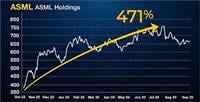Ticker Reports for September 7th
Is Merck Stock Undervalued After Its Colossal Earnings Growth?
Merck & Co., Inc. (NYSE: MRK) is one of the largest pharmaceutical firms in the world. The firm ranks fourth behind giants like Eli Lilly (NYSE :LLY) and Novo Nordisk (NYSE: NVO), with a market capitalization of $294 billion.
The company’s forward price-to-earnings (P/E) ratio sits at 13x. Compared to a peer group of the world's 10 largest pharma companies, this is well below the average of 20x. According to FactSet Earnings Insight, the healthcare sector has experienced the fourth-largest earnings growth in the past 12 months among all eleven sectors.
Which company has contributed the most to this earnings growth? The answer is Merck. The company has experienced a massive inversion in its adjusted earnings per share (EPS). In Q2 2023, the number stood at -$2.06; as of Q2 this year, it has flipped to $2.28.
Earnings in the entire healthcare sector have increased by 17%. However, without Merck’s contribution, the sector’s earnings would have declined by nearly 2%. Thus, the company has not only been able to vastly grow its own earnings but also keep its entire sector’s earnings from declining.
Due to this, Merck’s shares have surely appreciated greatly over the past 12 months, right? That’s not the case at all. Over that time, the price of Merck’s shares has appreciated just 8%. Despite this colossal earnings growth, a relatively low forward P/E ratio, and the modest rise in shares, it seems fair to ask: is Merck undervalued?
To add some color to this question, let's get a better idea of Merck’s most important business lines and other aspects of the company to figure out what might be going on.
Merck: Two Drugs Dominate the Massive Firm, and Their Growth Is Slowing
Merck breaks down its business into two segments: Pharmaceuticals and Animal Health. Pharmaceuticals makes up the vast majority of total revenue, coming in at 88% in 2023. Looking further into sales from individual drugs, we see the firm is highly reliant on two treatments: Keytruda and Gardasil/Gardasil 9. They made up 43% and 15% of total revenue, respectively, in 2023.
Keytruda treats a litany of different cancers. Gardasil/Gardasil 9 is a vaccine that protects against multiple strains of the human papillomavirus (HPV). Since 2021, sales growth for both these drugs has slowed significantly.
In 2022, Keytruda grew by 24%, but then fell to 3% in 2023. However, sales growth recovered nicely to 16% in Q2 this year. Gardasil/Gardasil 9 grew by 21% in 2022 and 29% in 2023, but growth was just 1% in Q2.
What’s Going on With Merck’s Earnings?
Turning to the shift from negative EPS to positive, we see that Merck’s loss of $2.06 per share in Q2 2023 was due to the acquisition of Prometheus Biosciences. This resulted in a one-time charge of $4.02 per share. So, without the acquisition, adjusted EPS would have been $1.96.
In Q4 2023, adjusted EPS was $0.03, driven by a one-time charge of $1.69 for its collaboration with Daiichi Sankyo (OTCMKTS: DSNKY). So, it's evident that these massive drops in EPS weren’t due to the company performing badly internally. Rather, the company had to record huge and abnormal increases in its research and development (R&D) costs to account for these events. The company did not stage a huge turnaround in its operations but made large investments, which it had to account for.
Taking out these one-time charges, the company’s average adjusted EPS over the past five quarters would be $2.03. The company’s current EPS is $2.28, about 12% higher than this average.
Final Thoughts on Merck’s Earnings and R&D
Although Merck doesn’t have a turnaround story, it has still been outperforming expectations. Despite making large investments in its future, it has beaten both revenue and adjusted EPS estimates over each of the last five quarters.
However, it may not be getting much credit for these investments because they won’t provide revenue benefits in the short term. Prometheus had no approved drugs, and there haven’t been any updates on its flagship drugs since the acquisition.
The Daichii collaboration also failed recently in June, with the first drug the two firms are partnering on being rejected by the Food and Drug Administration (FDA). This rejection will extend the time it could take Merck to make sales through the partnership.
Although the stock could still be upside, the average Wall Street price target for Merck is $139, implying an upside of 17%.
Who are Nvidia's New Silent Partners?
Nvidia recently became just the third $2 trillion company.
But Nvidia can't do everything by itself.
Top 5 ETFs for Every Investor: From Semiconductors to Defense
Exchange-traded funds (ETFs) have the potential to be an excellent choice both for amateur investors eager to diversify a portfolio but without the experience or time to deal with the regular management of a large number of positions as well as seasoned investors trading actively to capitalize on advanced leveraged strategies. It's no wonder that these easy-to-use investment vehicles have ballooned in popularity in recent years.
Before investing in an ETF, though, it's essential to understand the way that these funds are structured and the costs associated with them. In many cases, the fees associated with investing in an ETF—known as the expense ratio—have been driven lower by fierce competition from multiple providers offering similar products. At the same time, some funds may be quite expensive and use highly advanced strategies best suited to specialist investors.
Given thousands of different ETFs are available for investment, each investor will need to gauge their own goals and interests before comparing similar funds and making a selection. Niche funds may appeal to particular investment goals but may also offer low assets under management (AUM) or trading volume levels, which can cause liquidity and cost concerns. Fortunately, many ETFs are generally a good bet for investors of all experience levels.
VanEck Semiconductor ETF: Capitalize on the Chip Craze
Semiconductor stocks have had a tremendous run in recent months, with two leaders—NVIDIA Corp. (NASDAQ: NVDA) and Taiwan Semiconductor Manufacturing Co. Ltd. (NYSE: TSM)—now among the ten largest companies in the world by market capitalization. Still, as NVIDIA has demonstrated with its recent share price decline, investing in individual chipmakers carries risks despite the extreme popularity of many of these firms.
The VanEck Semiconductor ETF (NASDAQ: SMH) provides a greater degree of diversification within this industry than most investors are likely to achieve by targeting individual firms. This fund tracks 25 leading U.S.-listed semiconductor makers and offers a balance between megacap, large-cap, and mid-cap companies as a way of controlling risk.
With an expense ratio of 0.35%, SMH is moderately priced. To be sure, there are less expensive alternatives, but many of these are broader information technology sector funds that do not provide the same targeted exposure to semiconductor firms. SMH also has strong liquidity based on large monthly trading volumes, so investors are not likely to face any barriers entering or exiting this fund.
iShares MSCI Global Gold Miners ETF: Combat Inflation Without Direct Gold Exposure
Gold is trading near an all-time high after reaching a record earlier this year, the likely result of lingering concerns about inflation, the potential for a recession, uncertainty about interest rates, and general hesitation about market volatility.
For some investors, physical gold is an ideal safe haven when faced with market turbulence. However, direct investments in gold also bring challenges including storage and maintenance, security, and liquidity. An arguably easier alternative in the ETF space is the iShares MSCI Global Gold Miners ETF (NASDAQ: RING).
RING does not offer direct exposure to physical gold, but rather tracks a basket of nearly 40 international gold mining companies as a proxy for the price of gold. This structure allows for diversification across dozens of different companies as well as the potential for dividend income.
RING's expense ratio is fairly high compared to many ETFs at 0.39%, but it remains lower than many other funds in the gold mining category. Another major benefit it enjoys over multiple other gold miner ETFs is its international focus. Gold mining is an industry spread out throughout the world and in both developed and emerging markets, and RING's holdings provide a healthy mix of each.
Global X Defense Tech ETF: Benefit From Increased Defense Spending
An unfortunate reality of increased geopolitical conflict in Ukraine and the Middle East is that many nations have accelerated the pace of growth of their defense spending. Global military spending for 2023 was $2.4 trillion, an increase of almost 7% over 2022.
In the niche category of defense technology funds, the Global X Defense Tech ETF (NYSEARCA: SHLD) stands out for its year-to-date returns above 31%. The fund is fairly focused, with fewer than 40 companies included, and it is limited to U.S. names.
Notably, SHLD is a smaller and less-liquid fund than some of the others in this list, with AUM of $522 million and a 1-month average trading volume in the 200,000s. It also has higher fees, with an expense ratio of 0.50%, and only about a year's track record since launch. Nonetheless, if current defense spending trends continue it seems likely that SHLD will provide strong returns.
Invesco S&P 500 Momentum ETF: Building on Current Trends
Investors not especially focused on a particular theme or sector but still wishing to capitalize on the latest momentum picks without actively managing their portfolios may turn to the Invesco S&P 500 Momentum ETF (NYSEARCA: SPMO).
SPMO holds a portfolio of 100 stocks from the S&P 500 that have a history of leading share price growth compared with other companies in the index. By targeting companies with strong returns on this scale—and focusing on the well-established companies making up the S&P 500—this ETF mitigates much of the risk involved with investing in a single momentum stock.
Still, due to the shifting nature of momentum stocks, this fund tends to draw investors looking to trade ETFs fairly actively, as opposed to hands-off investors looking to buy and hold. Fortunately, its low expense ratio of 0.13% makes active trading possible without becoming too costly.
Vanguard S&P 500 ETF: Inexpensive Exposure to Major Index
The S&P 500 is up more than 22% in the year leading up to September 5, and while this level of return is not necessarily consistent, the market does trend upward over the long term. This makes funds tracking the S&P 500 a stalwart for many investors interested in the ETF space.
Among S&P 500 ETFs, there has been a race to provide the most enticing expense ratio, as funds targeting this benchmark index are in many other respects essentially equal. The Vanguard S&P 500 ETF (NYSEARCA: VOO) is not as well-known as its rival SPDR S&P 500 ETF Trust (NYSEARCA: SPY), but it is quite a bit cheaper for investors. VOO has an expense ratio of 0.03%, while SPY's is three times that at 0.09%.
VOO has comparable AUM to SPY, but it does lag behind its rival in liquidity. Nonetheless, with a 1-month average trading volume of more than 5,000,000, VOO is not likely to give investors any liquidity concerns.
Theme or No Theme
A decision ETF investors must make is whether to focus on funds with a particular investing theme, or instead to target those that provide broad-based exposure to larger indices or portfolios. The funds above provide a mixture of each and, together, represent a number of different approaches to ETF investment.
Central Bank Ditches U.S. Dollar
Startling new evidence shows the U.S. Central Bank is abandoning the currency we've relied on for centuries – the United States Dollar…
And placing a 'quiet bet' on a new type of currency…
Gold.
Blade Air Mobility: This Under-the-Radar Stock Could Double Soon
Blade Air Mobility (NASDAQ: BLDE) is not only a stock with an interesting name, but it could also be a big-time investment, according to Wall Street analysts. Its average price target of $7.30, implies this stock could provide a double bagger return or greater.
However, the skies haven’t been all that clear lately for the firm’s share price. The company’s three-year total return is -67%, and year to date, it's down 18%. This leaves the industrial company greatly trailing its sector in 2024. The Industrial Select Sector SPDR Fund (NYSEARCA: XLI) has provided a total return of over 12%.
Let’s explore what exactly Blade Air Mobility does and its opportunities to understand the potential reasoning behind analysts' bullishness.
Blade: An Innovator in Urban Air Logistics
Blade has two operating segments: Passenger and Medical. The Passenger segment consists of two key products: short-distance and jet. The short-distance product provides helicopter and seaplane travel in the U.S., Canada, and Europe for distances under 100 miles.
Meanwhile, the jet product primarily generates revenue through charters and by-the-seat transport between New York and South Florida.
One key point about Blade’s business model is that it only owns 10% of its aircraft. Described as "asset-light," the company contracts out most of the actual flying to third parties. Blade pays these parties fixed hourly rates, ensuring that they only bear costs when flights actually occur.
Blade provides value in organizing the logistics of this travel. Its “customer-to-cockpit” software allows it to manage and track flights in real-time. It also provides passengers, pilots, and hospitals with customized information that is important to them.
The Medical segment contains the MediMobility Organ Transport service. This service transports human organs from donors to recipients quickly. When donating organs, it is important to complete the process fast.
For example, if someone needs a heart transplant, they will only be able to get it from a recently deceased donor. Once you remove the heart from the body, it can only survive for several hours. In this scenario, Blade’s software would organize the logistics of transporting the organs quickly. Blade’s aircraft operators would then transport the heart from the donor’s hospital to the recipient's hospital to help ensure the transplant would be successful.
At the beginning of the firm’s history, its passenger segment was the primary source of revenue. However, in 2022, the company unlocked a massive demand in the medical segment, and revenues increased by 380%.
Mixed Recent Financial Performance
Strong growth in the segment continued in 2023, with revenue rising 76%. Over the past six months, MediMobility made up 62% of the firm’s total revenue. Short distance accounted for 26%, and Jet accounted for 12%.
Over two of the last four quarters, the company has achieved positive earnings before interest, taxes, depreciation, and amortization (EBITDA). The first time it achieved this was in Q3 2023. The operating margin of the last 12 months improved from -41% in Q2 2022 to -17% in the latest quarter.
However, revenue growth has slowed rapidly, coming in at just 11% last quarter. Blade is still a small firm and needs to find a way to grow faster.
Geographic Expansion and Next-Gen Aircraft Could Reinvigorate Growth for Blade
In the long term, analysts may base their lofty price targets for Blade on an infusion of growth and profitability through two ways: geographic expansion and Electric Vertical Aircraft (EVAs). Blade has a lot of room to expand within the U.S., where it gets 84% of its revenue.
Blade's primary markets right now are New York, Los Angeles, and Miami, but it can still expand to many other cities throughout the country and internationally. Blade's new partnership with Qatar Airways will connect customers with helicopter transit to Monaco.
Additionally, the adoption of EVAs could help reduce costs and increase profits. Companies like Joby Aviation (NYSE: JOBY) and Archer Aviation (NYSE: ACHR) are working on this technology. Experts expect Joby's revenues to rise to $1.8 billion by 2029. Today, they are almost nothing. This suggests a potential explosion in demand for this technology over the coming years.
Blade predicts that using EVAs could immediately translate to a 14% cost reduction per flight and, over time, a 24% cost reduction. This would go a long way toward helping the firm be consistently profitable. It could also promote growth, allowing the firm to charge lower rates and reach a group of less wealthy customers.





0 Response to "🌟 Top 5 ETFs for Every Investor: From Semiconductors to Defense"
Post a Comment